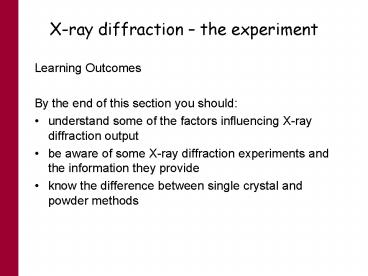Xray diffraction the experiment - PowerPoint PPT Presentation
1 / 28
Title:
Xray diffraction the experiment
Description:
understand some of the factors influencing X-ray diffraction output ... Counter - Diffractometer. Bruker D8 Advance. X-ray tube. detector. sample. More detail ... – PowerPoint PPT presentation
Number of Views:307
Avg rating:3.0/5.0
Title: Xray diffraction the experiment
1
X-ray diffraction the experiment
- Learning Outcomes
- By the end of this section you should
- understand some of the factors influencing X-ray
diffraction output - be aware of some X-ray diffraction experiments
and the information they provide - know the difference between single crystal and
powder methods
2
Methods and Instruments
All are based on
- Sample can be
- Single crystal
- Powder - (what is a powder?!)
3
X-rays - interactions
- First assumption X-rays elastically scattered by
electrons. - Second assumption Spherical, discrete atoms
- J. J. Thomsons classical theory of X-ray
scattering. - X-ray output is defined through the scattering
cross-section.
where r0 is the classical electron radius.
Very weak interaction. Thus need lots of
electrons, and thus many atoms.
J. J. Thomson, Conduction of Electricity through
Gases
4
Scattering factor
- More electrons means more scattering (? Z)
- Scattering per electron adds together, so helium
scatters twice as strongly as H
- We define an atomic (X-ray) scattering factor,
fj, which depends on - the number of electrons in the atom (Z)
- the angle of scattering
5
Function of deflection angle
- f varies as a function of angle ?, usually quoted
as a function of (sin ?)/?
The more diffuse the electron cloud, the more
rapid the reduction in the scattering function
with scattering angle.
http//www.ruppweb.org/xray/comp/scatfac.htm
6
Deflection angle / atomic number
- Different elements show the same trend note the
starting value
http//www.ruppweb.org/xray/comp/scatfac.htm
7
f ? Z (ish)
- For ? 0, f is equal to the total number of
electrons in the atom, so - f?0 Z
Ca2 and Cl- both have 18 electrons. So at ?0
fCa 18 fCl But as ? increases, Cl- has
smaller f as it has a more diffuse electron cloud
8
What is important?
- Lots of scattering centres
- Large enough crystals (lots of planes)
- Long range order (otherwise??)
Glass crystallising with temperature
Broad, featureless pattern. Some information can
be retrieved (e.g. average atomic distances) but
no structure.
9
Bragg (again!!)
- Look at Bragg set-up with different emphasis
Thus the scattering from this plane will reflect
which atoms are in the plane. Turn the crystal.
10
Bragg (again!!)
d expands
- Changes d-spacing and atoms within the planes
- So we need to either (a) rotate the crystal or
(b) have lots of crystals at different
orientations simultaneously
11
Laue Method
Max Von Laue 1879-1960 Nobel Prize 1914
http//www.matter.org.uk/diffraction/x-ray/laue_me
thod.htm
12
Laue Method
http//www-xray.fzu.cz/xraygroup/www/laue.html
13
Laue Method
Each spot corresponds to a different crystal plane
- USES
- alignment of single crystal
- info on unit cell
- info on imperfections, defects in crystal
Not so common these days
14
4-circle Method
Monochromatic X-rays
Moving detector
Movingsingle crystal
Crystal can be oriented so that intensities for
any (hkl) value can be measured
15
Actual instrument
- http//www.lks.physik.uni-erlangen.de/equipmen/equ
ipmen.html
16
Now more common to use area detector which
removes one circle.
17
Bruker SMART
- Area detector
18
Output
List of hkl (each spot represents a plane) and
intensity 1000s of data points needed
19
Uses
- Unit cell determination
- Crystal structure determination (primary method)
- We will come to the theory later on
Weve also used ours to get information on
vertebral disks!!
20
Powder Diffraction
By powder, we mean polycrystalline, so equally
we can use a piece of metal, bone, etc. We
assume that the crystals are randomly oriented so
that there are always some crystals oriented to
satisfy the Bragg condition for any set of planes
21
Film - Debye Scherrer Camera
Camera radius R
22
Debye-Scherrer Camera
- Now obsolete!
Peter Debye, 1884-1966 Nobel Prize 1936
23
Counter - Diffractometer
- Bruker D8 Advance
detector
X-ray tube
sample
24
More detail
25
Not all are the same
X-ray tube
Furnace
Detector
Sample
Detector
- Stoe Stadi/P
26
Output
- Plot of intensity of diffracted beam vs.
scattering angle (2?)
27
The Powder Pattern
- The whole pattern is a representation of the
crystal structure - Not like some other techniques like spectroscopy
- Next section we will examine the uses in more
detail, then the details behind the pattern
28
Summary
- Diffraction experiments consist of a source, a
sample and a detector - Samples can be single crystal or powder
(polycrystalline) - Single crystal is a primary technique for
structure determination - Powder diffraction relies on a random orientation
of (small) crystallites































